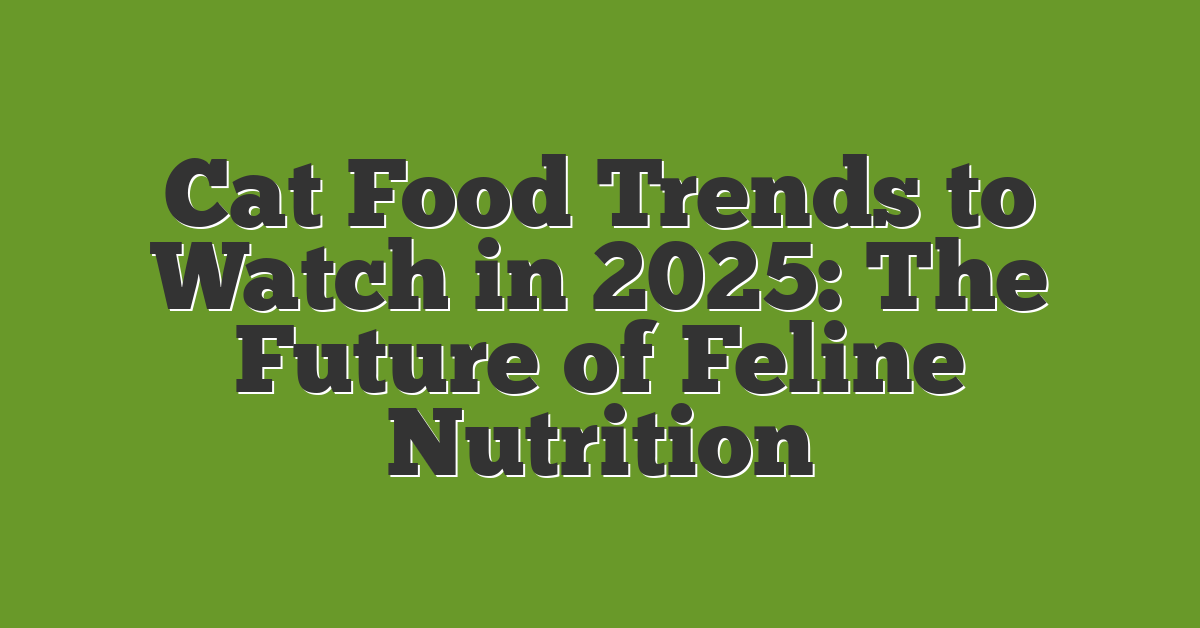As a cat lover, you want the best for your furry friend. Feeding your cat goes beyond just filling their bowl—it’s about providing the right nutrition to keep them healthy and happy. With the pet food industry constantly evolving, staying updated on the latest trends can make a big difference in your cat’s well-being.

In 2025, expect some exciting innovations in cat food that cater to your pet’s unique needs. From sustainable and eco-friendly ingredients to specialized diets addressing specific health concerns, the options are expanding. You’ll also see more personalized nutrition plans that consider your cat’s age, weight, and activity level, ensuring they receive exactly what they need.
Embracing these trends not only enhances your cat’s diet but also strengthens the bond you share. Let’s explore the top cat food trends to watch in 2025 and discover how you can make the best choices for your beloved companion.
Natural And Organic Ingredients
Choosing natural and organic cat food ensures your feline friend gets the best nutrition. These ingredients support your cat’s health and well-being.
Emphasis On Whole Foods
Whole foods dominate the 2025 cat food trends. You’ll find more real meat, vegetables, and grains in your cat’s diet. These ingredients provide essential nutrients that support your cat’s overall health. Whole foods help maintain a healthy weight and improve digestion.
Reduction Of Artificial Additives
Artificial additives are becoming less common in cat food. You can expect fewer artificial colors, flavors, and preservatives. Removing these additives reduces the risk of allergies and other health issues. Cleaner labels make it easier for you to choose healthy options for your cat.
Personalized Nutrition For Cats
Tailoring your cat’s diet ensures they get the nutrients they need. Personalized nutrition helps improve their health and happiness.
Customized Diet Plans
Create diet plans that fit your cat’s unique needs. Options include:
- Age-specific diets: Kittens, adults, and seniors have different nutritional requirements.
- Weight management: Control your cat’s weight with balanced calorie intake.
- Allergy-friendly meals: Avoid ingredients that cause your cat to react.
- Activity level adjustments: Active cats may need more protein and calories.
Genetic Testing For Dietary Needs
- Identify food sensitivities: Discover which ingredients your cat can’t tolerate.
- Optimize nutrient absorption: Tailor diets to enhance nutrient uptake.
- Prevent hereditary conditions: Use genetic information to avoid future health issues.
- Personalized meal plans: Base your cat’s diet on their genetic makeup for better health outcomes.
Sustainable And Eco-Friendly Packaging
Packaging is essential for keeping your cat’s food fresh. You’ll see more eco-friendly options emerging in 2025.
Biodegradable Packaging Options
You’ll find cat food in biodegradable bags made from plant materials. These bags break down naturally, reducing landfill waste. Compostable containers are also popular, offering a greener alternative to traditional plastic.
Eco-Conscious Production Methods
Manufacturers use renewable energy to produce cat food packaging. They also source materials sustainably, ensuring minimal environmental impact. Water usage is reduced during production, further supporting eco-friendly practices.
Functional And Health-Focused Foods
You can enhance your cat’s diet with foods designed for their specific health needs. These options support overall well-being and address common feline health issues.
Probiotics And Digestive Health
Probiotics help maintain your cat’s gut health. They aid digestion and boost the immune system. Foods with probiotics can reduce stomach upset and improve nutrient absorption. Look for cat foods that list live cultures like Lactobacillus or Bifidobacterium on the label.
Weight Management Formulas
Weight management formulas control your cat’s calorie intake. They help maintain a healthy weight and prevent obesity-related diseases. These foods often contain higher fiber content to keep your cat feeling full. Choose options with balanced nutrients to support an active lifestyle and overall health.
Alternative Protein Sources
Exploring new protein sources supports your cat’s health and the planet. These alternatives offer high-quality nutrition while promoting sustainability.
Insect-Based Proteins
Insect proteins are eco-friendly and highly nutritious. They contain essential amino acids and are easy to digest. For example, black soldier fly larvae provide protein with minimal land and water use. Insect-based cat foods are low in allergens, making them ideal for cats with food sensitivities.
Plant-Based Alternatives
Plant proteins are gaining popularity in cat food. Ingredients like peas, lentils, and chickpeas offer sustainable protein sources. These proteins help reduce the carbon footprint of pet food production. Additionally, plant-based proteins provide fiber, which aids digestion and supports a healthy weight in cats.
Conclusion
Embracing these trends means you’re prioritizing your cat’s health and the planet too. With more sustainable options and personalized nutrition, you can ensure your furry friend thrives. It’s exciting to see how the pet food industry is evolving to meet both your needs and your cat’s. Stay tuned and choose wisely to keep your kitty happy and healthy in 2025 and beyond.










